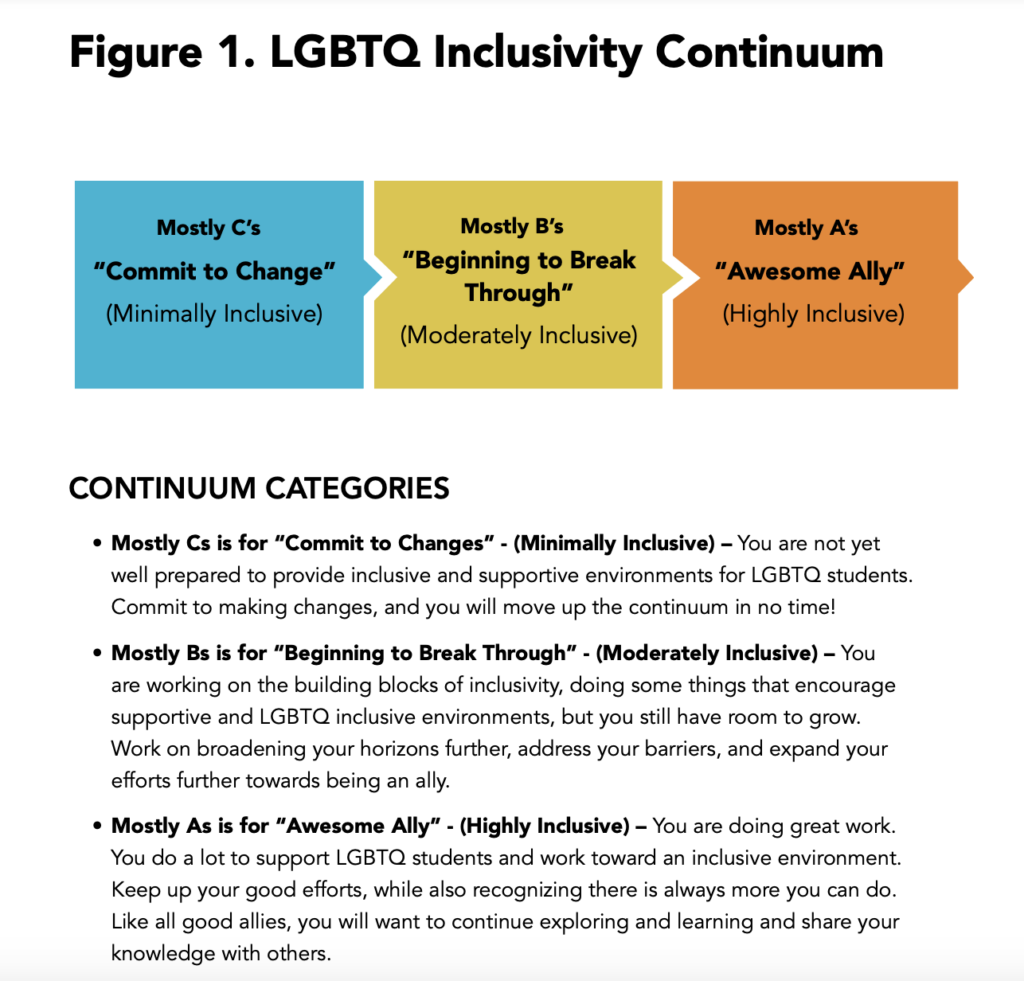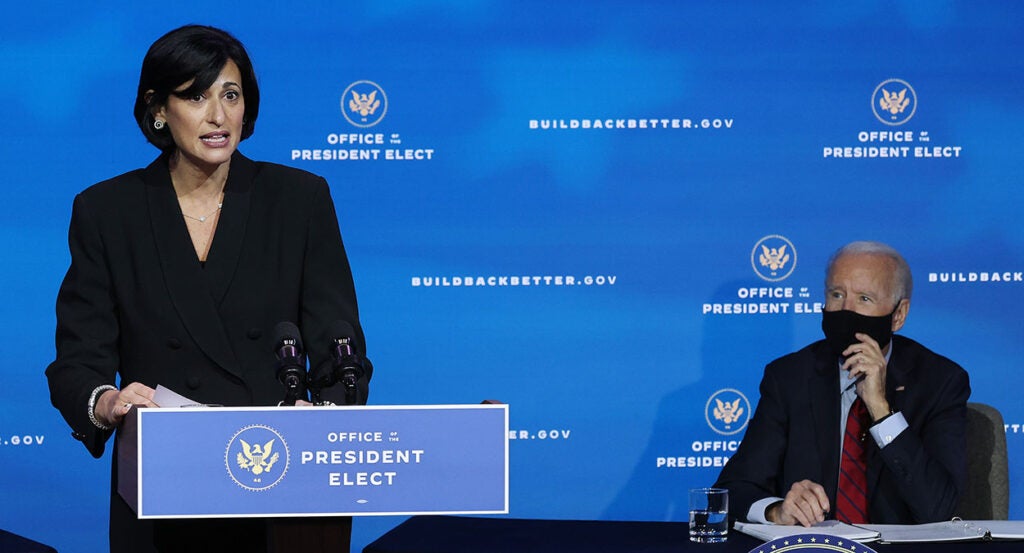Just days after Christmas, the Centers for Disease Control and Prevention republished a “self-assessment tool” urging teachers, administrators, school health staff, and others to become an “awesome ally” by advocating for LGBT causes in school.
The document cites multiple LGBT activist groups, including a division of the Southern Poverty Law Center (SPLC).
The CDC did not respond to The Daily Signal’s request for comment about the document, which it originally published in October 2020.
“School administrators: Our LGBTQ inclusivity self-assessment tool can help you quickly gauge inclusivity at your school,” the CDC’s Division of Adolescent and School Health posted on Twitter on Tuesday. “See your score today and learn ways to increase inclusivity.”
The document, “LGBTQ Inclusivity in Schools: A Self-Assessment Tool,” appears on the CDC’s youth website in a section “For Schools” and under the drop-down “Tools for Supporting LGBTQ Youth.”
“Schools play a critical role in supporting the health and academic development of all youth, including the success of lesbian, gay, bisexual, transgender, and queer/questioning (LGBTQ) youth,” the document states. “Creating and sustaining inclusive school environments, policies, programs, and practices that include LGBTQ youth is one strategy for improving the health and academic success of all youth.”
The document notes that it includes resources from nongovernmental organizations “focused on improving school inclusivity” and that the resources do not represent the CDC’s official opinion. The document further notes that the self-assessment tool is optional, not required, but it touts the document as “a focused, reasonable, and user-friendly approach to identify strategies to increase LGBTQ inclusivity in schools.”
The tool includes four assessments, one each for all users, administrators, educators, and school health services staff. The tool includes three scores: “Commit to Change,” “Beginning to Break Through,” and “Awesome Ally.”

The general self-assessment encourages education leaders to adopt certain mindsets, such as “I cannot assume a student’s gender, gender identity, or sexual orientation,” and urges them to adopt “inclusive” terminology, such as “using individuals’ chosen names/pronouns” and rejecting terms like “boyfriend” and “girlfriend” for “neutral terms” like “partner.”
It also encourages leaders to “advocate for LGBTQ inclusive and affirming materials in all school and classroom environments” and to participate in the school’s Gay-Straight Alliance.
This section also lists resources from activist groups such as GLAAD, the Human Rights Campaign, and PFLAG, along with the infamous “Gender Unicorn” graphic presenting biological sex as inherently different from gender identity.
The next section encourages administrators to alter their school health policies to include explicit anti-bullying and nondiscrimination policies for LGBTQ students, to allow “students to use the bathroom/locker room which aligns to their chosen gender,” to allow students to alter their paperwork “to present their chosen name and pronouns, rather than their legal name,” and to allow students “access to age-appropriate LGBTQ content and information.” It also encourages administrators to let teachers “develop LGBTQ inclusive curricula” and to support teachers attending LGBTQ trainings.
The document encourages educators to put up “visual labels” such as “rainbow flags, pink triangles, unisex bathroom signs” marking a classroom as “a safe space for LGBTQ students.” It urges them to teach with “LGBTQ inclusive” content and to attend LGBT trainings.
The document also urges teachers to “describe anatomy and physiology separate from gender (e.g., ‘a body with a penis’ and ‘a body with a vagina’).”
Finally, the document urges health services staff to set up “visual labels” to demonstrate support for LGBT causes in the school’s clinic, to offer intake forms with separate sections for “gender identity and sex at birth,” to use students’ chosen names and pronouns, to offer “LGBTQ-specific health pamphlets” at the school clinic, to “describe anatomy and physiology separate from gender,” and to attend LGBT trainings.
Although the CDC document insists the “self-assessment” is voluntary and does not represent an endorsement of LGBT activist groups, it encourages teachers, administrators, and health staff to endorse LGBT activist symbols, consult with LGBT activist organizations, and change school policies in an LGBT activist direction.
Parents have urged schools to remove certain books from libraries, such as Maia Kobabe’s “Gender Queer: A Memoir.” Although the book includes pictures of sexual acts between a boy and a man, a Fairfax County Public Schools committee defended the book, saying it depicts “difficulties nonbinary and asexual individuals may face.” The committee concluded that “the book neither depicts nor describes pedophilia,” but parents have contested this assertion.
While the CDC document does not reference “Gender Queer,” it does cite Teaching Tolerance, a project of the left-leaning SPLC which has since rebranded itself as Learning for Justice. According to critics, the SPLC brands mainstream conservative and Christian organizations “hate groups,” putting them on a map with chapters of the Ku Klux Klan. In 2012, a man used the SPLC “hate map” to target the Family Research Council in a terrorist attack. He was convicted of terrorism.
As I note in my book, “Making Hate Pay: The Corruption of the Southern Poverty Law Center,” the SPLC fired its co-founder and had its president resign amid a racial discrimination and sexual harassment scandal in 2019. During that scandal, a former SPLC staffer admitted that the organization’s accusations of “hate” are a “cynical fundraising scam” aimed at “bilking Northern liberals.”
The CDC did not respond to questions regarding its decision to cite the SPLC.
The CDC also did not respond to questions about how it might defend the LGBT “self-assessment tool” as a necessary health measure. It also did not respond to questions regarding its apparent endorsement of transgender ideology.
While many national health organizations support experimental transgender medical interventions in the name of “gender-affirming care,” medical organizations both in the U.S. and around the world are reversing course. The Florida Board of Medicine and the Florida Board of Osteopathic Medicine last month approved a new rule banning puberty blockers, cross-sex hormones, and transgender surgeries for minors.
Karolinska Hospital in Sweden announced in May 2021 that it would not prescribe hormonal treatments to minors under 16. In June 2021, Finland released medical guidelines opposing such drugs for minors, noting: “Cross-sex identification in childhood, even in extreme cases, generally disappears during puberty.” In April 2021, Britain’s National Institute of Health and Care Excellence concluded that the evidence for using puberty-blocking drugs to treat young people is “very low” and that existing studies of the drugs were small and “subject to bias and confounding.”
The CDC also did not respond to concerns that the document represents activism in the name of promoting public health. The agency also declined to comment on whether it would consider promoting alternative materials from organizations that do not endorse LGBT activism.
Have an opinion about this article? To sound off, please email letters@DailySignal.com and we’ll consider publishing your edited remarks in our regular “We Hear You” feature. Remember to include the url or headline of the article plus your name and town and/or state.
